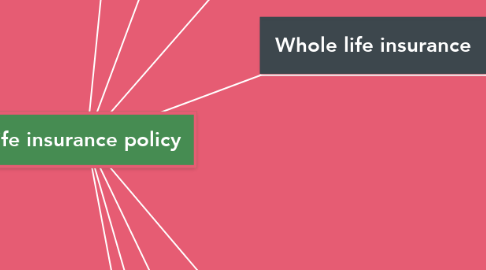
1. Term life insurance
1.1. Provides full risk cover against Any type of eventuality
1.1.1. Benefits: It provides higher cover for lesser premium as compared to other life insurance products
1.1.1.1. Eligibility- even if you are below the age of 45, you can buy a Ulip with a minimum sum assured of seven times the annual premium as against an earlier minimum sum assured of ten times. Earlier, only people over 45 years of age were eligible to buy Ulips with sum assured less than 10 times of annual premium.
2. Whole life insurance
2.1. Offers liglfe insurance coverage Till 100 years of age.
2.1.1. Benefits: Unlike other insurance policies, it does not have a defined term. The sum assured is paid to the dependent upon the death of the policyholder.
2.1.1.1. Eligibility - You should be at at least 18 years of age. There are some plans that are available to infants of 30 days as well. You should not exceed the age of 60 years upon entry into the plan. The maximum age upon maturity is 100 years.
3. Endowment life insurance policy
3.1. Provides the combined benefits of life insurance cum saving
3.1.1. Benefits: Apart from the sum assured there is a saving component. You can use this to make goal-based savings and in case of financial emergencies, you can avail of a loan against it
3.1.1.1. Eligibility- 90 days to 65 year's of age Minimum sum assured ₹50000 Maximum no limit Policy term 10-25 years Single premium depends on age, terms and sum assured
4. Money back insurance policy
4.1. Provides periodic return along with the benefits of life insurance cover
4.1.1. Benefits: The biggest advantage of moneyback policies is the liquidity it provides, i.e. you receive a percentage of the sum assured at the regular interval.
4.1.1.1. Eligibility- Policyholder should be above the minimum entry age and below the maximum entry age (varies from policy to policy). Policyholder should be able to pay the Sum Assured as per the policy guidelines.
5. Saving and investment insurance plan
5.1. Provides an opportunity to save and gain long-term investment returns
5.1.1. Benefits: They also give you the option of selecting funds as per your choice. Many ULIPs also offer the possibility of increasing your premiums during your premium paying term.
5.1.1.1. Eligibility- 1.5 lakhs are eligible for tax exemption U/S 80 C of Income Tax Act. National Savings Certificate is best suited for mid-income investors, who have a low-risk appetite. NSC is similar to other fixed-income investment options such as Public Provident Fund (PPF) and Post-Office Fixed Deposits.
6. Retirement insurance plan
6.1. Helps to create a retirement corpus, so that you can retire gracefully
6.1.1. Benefits: Potential growth of your investment earnings that's tax deferred until you take a withdrawal or distribution.
6.1.1.1. Eligibility- Minimum and Maximum Entry Age: For most pension plans, the minimum age of entry is generally 30 while the maximum entry age is 75. Minimum and Maximum Vesting Age: In most cases, the minimum vesting age is 45 years while the maximum age is 80 years.
7. Child insurance policy
7.1. Helps to secure the future of your child
7.1.1. Benefits: While planning and managing your family’s finances, you devote a reasonable amount of time on your child’s future. Major requirements like child’s higher education need substantial savings, given the rapid rise in education costs
7.1.1.1. Eligibility- The usual entry age to buy a child plan is 18 to 21 years, and the maturity age can be up to 60 to 65 years. The sum assured also varies according to the plan. While some plans have no minimum criteria, others have criteria of at least 5 to 10 times of the annual premium amount
8. ULIP life insurance plan
8.1. Offers the benefits of investment cum life insurance
8.1.1. Benefits: Though there is no guaranteed return, ULIP provides a higher return than traditional policies with a savings component.
8.1.1.1. Eligibility- The minimum entry age is 18 years and the maximum ranges between 65-69 years. ... Most plans have premium cost bands in which the cost of insurance rises incrementally as per age groups. The premiums for each premium cost band are generally mentioned in the plan document.

